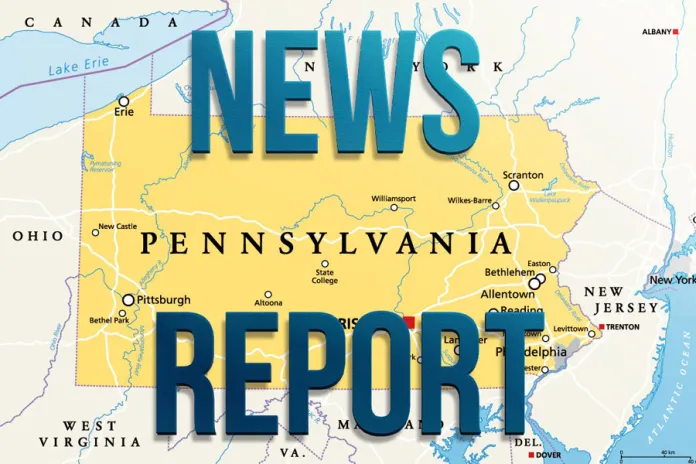LNP/LancasterOnline. February 12, 2023
Editorial: Ruling in landmark Pennsylvania public education funding lawsuit is just and long overdue.
If you’ve watched “Abbott Elementary,” the ABC sitcom set in Philadelphia and created by Quinta Brunson, the daughter of a longtime Philly teacher, you may have wondered if its fictional portrayal of a poor public school was exaggerated.
Could a public school, in 2023, really have textbooks stating that the current president is one who left the White House decades ago? Could the broken-down restrooms and crowdfunding for basic supplies in “Abbott Elementary” be more than figments of a sitcom writer’s imagination?
These indeed are realities for underfunded public schools across the state.
According to testimony noted by Judge Jubelirer, the School District of Lancaster’s physics textbook is 12 years old, “and some of its high school textbooks list countries that no longer exist.”
And those are the least of the indignities that children in Pennsylvania’s underfunded school districts have been forced to endure because the state government has failed — in Jubelirer’s assessment — to fulfill its obligation under the Pennsylvania Constitution.
That obligation? To provide access to an education that offers students a “meaningful opportunity to succeed academically, socially, and civically.”
It is clear, “based upon the credited testimony and evidence, that every student is not receiving that opportunity,” Jubelirer wrote.
We don’t know yet whether Republican Leader Cutler intends to appeal Jubelirer’s historic ruling, but we fervently hope he doesn’t. If an appeal is filed in the next few weeks, the Pennsylvania Supreme Court will hear it.
High-quality education is essential if we are to prepare the next generation of Pennsylvanians for citizenship in the 21st-century world and workplace. Depriving young Pennsylvanians of this education will create a drag on the state’s long-term economic growth.
Children’s advocate Donna Cooper told Spotlight PA that the lawsuit showed how systemic underfunding has hurt rural, suburban and urban schools across the commonwealth. This, in turn, diminishes the state’s future prosperity.
In the introduction to the ruling, Jubelirer cited Benjamin Franklin, who observed that an “investment in knowledge pays the best interest.”
Jubelirer is not a progressive ideologue, by any stretch of the imagination. The Commonwealth Court president judge ran for the bench as a Republican.
Her ruling is a searing indictment of the state Legislature. And if its recalcitrant leaders have any shame, they will work expeditiously to correct the wrongs highlighted in this landmark lawsuit.
Shame was what we felt when we read that the legislative leaders responding to the lawsuit contended that the facilities in which students learn only need to be “generally safe,” rather than safe and adequate.
Would they accept a “generally safe” school building for their own children?
Would they be comfortable sending their kids to learn in a school district that, because of low property values and the forced reliance on real estate tax revenue, couldn’t provide up-to-date equipment or even a temperate classroom climate?
The evidence in this lawsuit made it clear that there is an achievement gap between students in underfunded school districts and students in better-funded districts. In response to this gap, the Pennsylvania Department of Education set separate, lower goals for underserved students.
Retired School District of Lancaster Superintendent Damaris Rau testified that she was “shocked” by this. And it is truly shocking.
Former Deputy Education Secretary Matthew Stem, now the executive director of Lancaster-Lebanon Intermediate Unit 13, testified that the decision was made not because of the innate ability of certain students, but because of the severity of the inequities within Pennsylvania’s school funding system.
The evidence in the lawsuit — including the disparate graduation rates, attainment rates and standardized test scores between students in low-wealth and high-wealth school districts — all painted a portrait of a state failing too many of its children.
As Jubelirer noted, the court heard “extensive credible testimony from educational professionals and experts” about how school staff — such as guidance counselors, social workers, nurses, psychologists, instructional aides, reading specialists and tutors — help students succeed.
Several of the petitioning districts have such personnel, but too few to meet student needs. According to testimony, for instance, the School District of Lancaster’s 20 student and family resource specialists — social workers — have caseloads of 500 to 600 students each, and the district’s 11 psychologists carry caseloads of around 1,000 students each. How could these professionals possibly address the individual challenges of students burdened by poverty, language obstacles and learning differences?
Money “does matter, and economically-disadvantaged students and historically underperforming students can overcome challenges if they have access to the right resources that wealthier districts are financially able to provide,” Jubelirer wrote. (Those “historically underperforming” students include students of color, English language learners and students with special needs.)
Statistics, the judge wrote, “confirm what numerous witnesses testified as to: every child can learn, regardless of individual circumstances, with the right resources, albeit sometimes in different ways.”
The bolded text was the judge’s. It was bolded because it’s a critical point.
She concluded: “It is now the obligation of the Legislature, Executive Branch, and educators, to make the constitutional promise a reality in this Commonwealth.”
It is, though she did not specify just how they must do it. It will be a heavy lift — perhaps too heavy to accomplish in this year’s budget process.
In a statement last week, Democratic Gov. Josh Shapiro praised the ruling, noting that “creating real opportunity for our children begins in our schools, and I believe every child in Pennsylvania should have access to a high-quality education and safe learning environment, regardless of their (ZIP) code.”
According to The Associated Press, Bruce Baker, a University of Miami education professor who researches public school financing, has found Pennsylvania to be the most inequitable state for school funding, along with Illinois.
“Abbott Elementary” has made us famous for it. But it’s not a laughing matter. It’s an injustice that must be remedied without further delay.
Philadelphia Daily News/Inquirer. February 10, 2023
Editorial: At long last, an equitable ruling on school funding. Change must now follow swiftly.
Gov. Josh Shapiro and state lawmakers do not have to wait for the courts to tell them what is obvious to everyone: It is past time to properly fund public education for all students.
A Commonwealth Court judge found what many have long said about the way Pennsylvania pays for K-12 public education: The state’s method of funding schools is unfair and inadequate. Even more egregious, it is unconstitutional.
Judge Renée Cohn Jubelirer’s landmark 786-page decision is a long-overdue victory for students across the state — especially those in poorer rural and urban districts. It is also a triumph for justice, equality, and the rule of law.
However, when real change will come remains unclear.
After all, the lawsuit was first filed in 2014 and did not go to trial until November 2021. After three months of arguments, the ruling came a year later. The decision will likely be appealed to the Pennsylvania Supreme Court.
That process could take another year or so. If the Supreme Court upholds the decision, it will be left to the General Assembly and Gov. Josh Shapiro to determine how to properly fund the schools, as the judge’s ruling did not prescribe a remedy.
Kudos to the attorneys at the Education Law Center, the Public Interest Law Center, and the private firm of O’Melveny & Myers for their tenacity throughout the long legal process. They shined a light on the state’s inability to provide a “thorough and efficient” education for all children, as the Pennsylvania Constitution’s education clause requires.
Hurdles remain, but Shapiro and state lawmakers do not have to wait for the courts to tell them what is obvious to everyone: It is past time to properly fund public education for all students. As the Rev. Dr. Martin Luther King Jr. famously said, “The time is always right to do what is right.”
The price, though, will not be cheap. A Penn State professor’s analysis provided at the trial found it would take an additional $4.6 billion invested over time to adequately fund the schools. The entire state budget for 2022-23 is $45.2 billion.
In effect, to properly fund the schools, lawmakers would have to increase revenues by roughly 10%. Those revenues mainly come from three sources: sales taxes, personal income taxes, and corporate income taxes.
Republican lawmakers in Harrisburg will surely oppose tax increases and instead use the ruling to call for more school choice, which has failed to solve the state’s education woes.
The good news is Democrats control the state House, and Shapiro supports increasing education funding and making it more equitable for students in every zip code.
As state attorney general, Shapiro filed an amicus brief supporting the legal challenge to the current funding method. Shapiro’s brief said the “Commonwealth’s most fundamental need is an intelligent and informed citizenry, which will support our democratic institutions, grow our economy, and strengthen the foundations of our shared civic life.”
That cuts to the heart of the matter.
Pennsylvania does a good job of investing in the elderly. The state funds nursing homes, offers seniors property tax rebates, and earmarks lottery proceeds for a variety of programs that benefit senior citizens.
Now, Pennsylvania must also invest in its future.
Research shows that states with well-educated workers have stronger economies. One study found increasing student achievement to basic mastery levels across the country would increase the nation’s gross domestic product by $32 trillion, or 14.6%.
There is also a clear correlation that shows investing in education lowers crime. Pennsylvania spends more than $42,000 a year, per inmate, to house people in prison. The state would be better off investing in education, thus reducing prison costs and the number of incarcerated individuals.
Pennsylvania has long lagged behind other states in terms of funding public schools and job growth. Students in poorer school districts especially lack many basic resources, including books, libraries, counselors, and even enough teachers.
The state’s uneven funding was underscored during the pandemic, when schools in poorer districts lacked resources to transition to online learning, leaving kids to fall further behind.
Republicans in Harrisburg have long ignored education as an investment. More than a decade ago, then-Gov. Tom Corbett slashed education funding statewide by $1 billion and crippled Philadelphia’s schools.
Doug Mastriano, last year’s Republican nominee for governor, wanted to eliminate property taxes and give parents vouchers for $9,000, which would have effectively cut education funding by a third. Voters ensured that disaster was averted.
But Republicans in Washington have also been hostile to public education for more than a generation. Former President Ronald Reagan promised to kill the U.S. Department of Education in 1980. Donald Trump repeatedly proposed cutting billions in funding meant for after-school programs, teacher training, and grants.
Starving education is a losing policy on many levels. Public education is a public good. Pennsylvania students have already waited too long for state leaders to do what is right.
Pittsburgh Tribune-Review. February 14, 2023
Editorial: Food banks need more support in face of SNAP benefit changes
Since 2020, the number of people depending on SNAP benefits — the government program previously called food stamps — has grown. In 2019, the number of Pennsylvanians was 1.6 million. Today, it is 1.8 million.
The amount of money spent on the program in Pennsylvania has grown from $2.4 billion in 2019 to a high of $5.43 billion in 2021. It dropped back to $5.4 billion in 2022 and is expected to fall further in 2023 as an additional pandemic amount given to beneficiaries is discontinued in March.
This was going to be necessary. The increases couldn’t last forever. Recipients either were moved up to the maximum allowed for their family size or they received an additional $95 in benefits if they already were at that maximum. It was an important intervention at a time when shelves were empty and many of the service jobs that supported low-income families were in flux because of pandemic precautions.
The end to this program will bring a different kind of complication than the upheaval of Medicaid and CHIP approvals that comes in April. The food insecurity issue will not just affect the people who stop receiving the benefit.
It is almost guaranteed to hit the people who never qualified for it.
The Pittsburgh area became an example of the food insecurity issue in the early days of the pandemic when massive food bank lines showed the scope of need.
In the ensuing three years, many people still have relied on food banks and local pantries. Some of these are people who fall between the cracks of those who qualify for help and those who can get by without it. The inflation that has spiked so many once-affordable staples — including eggs, milk and bread — hasn’t helped.
Now, food banks are expecting the disappearing SNAP benefits to create even more demand.
“Everyone’s in an uproar and a panic,” said Chelsey Speed, CEO and founder of the Speed Family Blessing Box and Pantry in Arnold. “I’m doing everything I possibly can to get support to brace ourselves for that. It’s going to hit and hit hard.”
There also are people who won’t qualify for SNAP at all now, such as seniors who received a Social Security cost of living increase that moved them out of benefit eligibility.
The increased stress on nonprofit reserves will be felt by real people. It will require real work to alleviate it.
People have stepped up to do what they can to help food banks. So have businesses. Even government has made an effort, like Westmoreland County commissioners designating a portion of American Rescue Plan funds to tackle food insecurity.
But increased demand is going to require even more.
Food is more than just something that keeps us alive. It’s a way that we bond with each other — it’s how we celebrate, mourn and share. And, in the face of such pressure, food banks are going to need a lot more sharing.
Scranton Times-Tribune. February 12, 2023
Editorial: Don’t appeal school ruling; fix funding
Commonwealth Court Judge Renée Cohn Jubelirer’s historic decision on school funding, issued Wednesday, honors the state constitution’s clear intent to ensure that all children have access to a decent education.
In a 786-page ruling, she found unconstitutional the method by which the state government partially funds public schools, largely along lines alleged by six underfunded school districts, some parents and several education advocacy organizations who brought the case.
The constitution, she found, was “clearly, palpably, and plainly violated because of a failure to provide all students with access to a comprehensive, effective, and contemporary system of public education that will give them a meaningful opportunity to succeed academically, socially, and civically.”
Pennsylvania’s government, in effect, has two systems for distributing $7.4 billion in education funding, only about 35% of total public education spending. The Legislature adopted a “fair funding” formula in 2015, thus acknowledging that the previous formula had become unfair. But, because lawmakers did not want to diminish funding to some districts, it decided to distribute fairly only the money that it appropriated after 2015. The result is that the new, fair formula applies to less than 20% of all state education funding.
Underfunded districts — like those in Scranton, Wilkes-Barre and Hazleton — must make up the shortfall through local property taxes.
Because of vast disparities in wealth and the tax bases across the state’s 500 school districts, many districts are underfunded relative to more affluent districts.
Jubelirer’s order invalidates the system but does not specify how to fix it, which she left to the Legislature and governor. “The options for reform are virtually limitless,” she wrote.
True enough. But, this being Pennsylvania, the options for lawmakers to evade their responsibility for fair funding also are limitless.
The decision is appealable by Gov. Josh Shapiro, who likely will not do so given his support, as attorney general, for the underlying litigation, and by House Republicans.
Shapiro should get the reform ball rolling by proposing effective reforms in his upcoming budget address. And rather than appeal to buy time against reform, legislative Republicans should engage in the process so that access to public education is not determined by ZIP code alone.
Wilkes-Barre Citizens’ Voice. February 14, 2023
Editorial: Court ruling opens eyes on nonprofit taxes
Taxpayers reasonably wonder why some nonprofit organizations, such as big hospital systems, are tax-exempt while paying executives salaries of seven figures-plus.
It’s a fair question, which the Commonwealth Court partially answered Friday.
More than 75% of hospitals in Pennsylvania operate as tax-exempt nonprofits. The rationale is that they provide services, health care, that the government otherwise would have to provide at public expense. State law sets parameters to qualify for tax exemptions, including providing free essential public services. Traditionally, hospitals have been able to withstand challenges to their tax-exemptions by providing care regardless of patients’ ability to pay, which also is required by federal law.
The Avon Grove, Coatesville Area and Phoenixville Area school districts in Chester County contended that three Tower Health Hospitals in that county — Brandywine, Jennersville, Phoenixville — operated for profit rather than as nonprofits and, therefore, should be subject to local taxation. The Pottstown School District made a similar claim regarding Tower Health’s Pottstown Hospital in Montgomery County.
All of the hospitals reported operating losses, but the court noted that they did so after paying more than $43 million a year in various management fees to the parent company. And, the court found, some executive compensation was “eye-popping.” Executive bonuses as high as 40% of salaries, it said, were tied to the hospitals’ financial performance as if they were for-profit enterprises.
According to the court, the hospitals also reported as “uncompensated” care the difference between their Medicare or Medicaid reimbursements and what the hospitals would charge at retail. But the health system’s own witness testified that the “master charge sheet” used for comparison was meaningless. “The numbers, essentially, are pulled out of thin air because the hospital is required to have a charge sheet to satisfy federal requirements,” the court decision said.
If the ruling withstands a certain appeal to the state Supreme Court, the hospitals will have to pay hundreds of thousands of dollars a year, each, their respective school districts and, potentially, local and county governments.
Regardless of the appeal, the decision is a cue to the state Legislature to modernize the state’s antiquated law, to protect true nonprofits while ensuring that profit-making enterprises pay their fair share in taxes.
END







